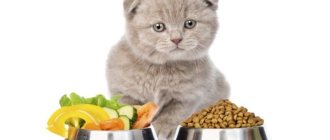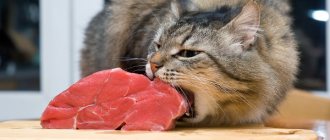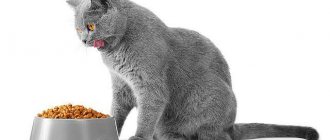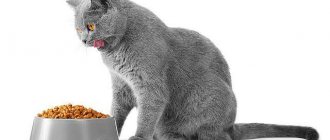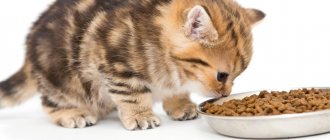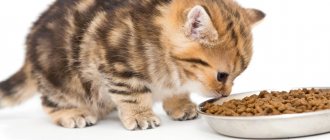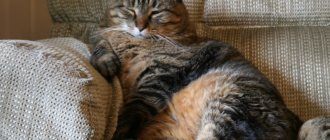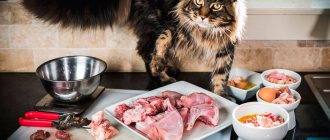| Place | Name | Characteristics in the rating |
| The best food for Scottish kittens |
| 1 | Wahre Liebe "Junge" | The best dry food with colostrum to strengthen the immune system |
| 2 | Hill's Science Plan Kitten Tuna | Balanced composition with Omega-3 and 6 |
| 3 | 1st Choice Kitten | High protein food, does not cause allergies |
| 4 | Royal Canin Kitten Instinctive | The best option for first feeding |
| 5 | Royal Canin British Shorthair Kitten | Prevention of joint diseases |
| The best food for adult Scottish cats |
| AlpenHof | Healthy treats made from natural dried meat | |
| 1 | Acana Pacifica for Cats | The best grain-free holistic food |
| 2 | Earthborn Holistic, Primitive Feline Natural Cat Food | Best Vitamin and Mineral Supplement |
| 3 | 1st Choice Adult Cat Chicken Formula | Super premium food, economical consumption |
| 4 | Royal Canin British Shorthair | Large croquettes of unusual shape for cleaning teeth |
| 5 | Flatazor Crocktail Adulte Poissons | Prevention of urolithiasis |
The best food for adult Scottish cats
As you grow older, your needs change and you have to switch to other foods. Veterinarians recommend paying attention to options of at least super premium class. As a last resort, you can temporarily buy premium food, but it is better to avoid the cheapest brands. Good food should contain at least 26-30% animal protein. Plant-based foods are acceptable, but undesirable - they are less digestible. Among carbohydrates, it is better to give preference to components such as rice and legumes - corn and wheat are not so healthy and sometimes cause allergies. Based on these requirements, we included five quality brands in the food rating for adult Scottish cats.
What not to feed
The health of your pet depends not only on a properly formulated diet, but also on knowing what not to feed your Scottish Fold or Straight-eared cat.
It is strictly forbidden to include the following products and additives in the diet of a fold-eared, straight-eared Scottish kitten:
- Any types of sweets and confectionery products lead to obesity
- It is unacceptable to feed Scottish Straight and Scottish Fold kittens chocolate.
- Lard, fatty meats and fish affect the liver;
- Adding salt, hot spices, pickles and marinade to food harms the kidneys and stomach;
- Fried, smoked meat and fish are poorly digested and harm the pancreas;
- Canned food contains salty, peppered foods with spices that are harmful to digestive and urinary function.
Important! Do not teach your Scottish cat to eat anything from the common table; such food is harmful to the pet’s health and develops bad behavior habits.
Advice from veterinarians
Veterinarians' advice on what to feed Scottish fold and straight-eared cats:
- Before purchasing a beloved pet, it is useful for owners to:
- get acquainted with the peculiarities of feeding Scottish fold and straight-eared kittens;
- Find out at the cattery what Scottish cats eat at birth and in what quantities.
- When feeding Scots, it is beneficial to use ready-made, high-quality specialized feed:
- Practically, it is much easier to acquire a solid supply of feed;
- Ease of use, no need to cook food;
- Cost-effective, it is more profitable to purchase balanced feeds than to buy the entire range of products separately.
- Long shelf life, unlike natural products.
Pets, Scottish fold and straight-eared cats, need proper and balanced nutrition. It is important from the first days of a kitten in the house to organize care, to take into account the nuances of nutrition during the growth of the pet at all stages of development, taking into account the characteristics of the breed.
Diet of a kitten up to a year by month
The digestive system of small kittens cannot process many foods that are allowed for adult cats. It is advisable to consider each stage of development of the Scots in order to feed the pet in accordance with its age.
0-1
The first month after birth, kittens do not need to be fed additionally - their mother's milk is enough for them. It is very nutritious and contains antibodies that form primary immunity.
Important. A nursing cat needs to eat heavily. During lactation, her body is greatly depleted.
If kittens cannot be breastfed, you need to buy special formulas - cat milk substitutes. They are sold in veterinary pharmacies.
It is not advisable to feed babies cow's milk. It contains less fat and protein, but more lactose, which is poorly digestible. Baby food is also not suitable - it is not intended for cats.
Immediately after birth, babies are fed 10-12 times a day, even at night. By the end of the second week, the number of feedings is reduced to 8 times, and by a month - to 6 times.
The amount of mixture is determined per 100 g of kitten weight:
- Days 1-5 – 30 ml;
- Days 6-13 – 38 ml;
- 14-24 days – 46 ml;
- Day 25-30 – 53 ml.
Newborn kittens cannot lap. To feed babies, you will have to use a bottle with a nipple, a pipette or a syringe. At 3 weeks they try pouring milk into a bowl. By this time, babies are able to eat on their own.
1-2
At 1 month, Scottish kittens are introduced to new food. Babies continue to eat milk, but in the intervals between feedings they are offered:
- chopped meat;
- fermented baked milk;
- cottage cheese;
- milk porridge.
A one-month-old kitten is fed 3-6 times a day, depending on the amount of mother's milk. The volume of solid food is 100-120 g.
2-3
At 2 months, Scottish kittens are still nursing their mother, but the proportion of solid food in the diet is increasing. Usually at this age, pets are prepared for transfer to new owners. They should already be able to eat on their own and do without the help of an adult cat.
If in the future the owner plans to feed the kitten industrial food, then it is better to accustom him to it now. To do this, buy wet canned food and dry granules. The former occupy about 90% of the diet, the latter – 10%. As they grow, the amount of “drying” is increased, and the share of wet food is reduced to 30%.
Important. Dry kibble and wet food are given at different times.
At 2 months, Scottish kittens are fed 6 times a day. The volume of food is 160-180 g.
The baby's diet is enriched with grated boiled vegetables. Stop turning the meat and cut it into small pieces.
The new owner should definitely ask the breeder what kind of food the Scottish kitten was fed. Babies should not be abruptly switched from one food to another. This is fraught with disruption of the gastrointestinal tract.
3-4
The kitten is actively growing and needs more and more food. The daily amount of food at 3 months is increased to 180-240 g, and the number of feedings is reduced to 4-5 times a day.
At this age, a crucial period begins - the change of teeth, due to which the need for calcium increases significantly. To replenish reserves, the Scotsman is given more fermented milk products. The diet is enriched with vitamin and mineral complexes, which are selected in consultation with a veterinarian.
Important. A Scottish kitten is no longer fed whole milk at 4 months of age. In adult cats, it is most often not absorbed.
4-5
By 4 months, the Scottish kitten's gastrointestinal tract becomes stronger. Now you can feed the baby:
- offal;
- sea fish;
- eggs;
- greens.
The meat is cut into larger pieces so that the baby can exercise his jaws.
Pets are fed fish with caution. Some Scots are allergic to it. If a negative reaction occurs, the product is excluded from the diet.
The growth rate of the kitten slows down slightly, so the daily amount of food remains the same - about 180-240 g. The number of feedings is reduced to 4 times a day, increasing the portions proportionally.
5-9
At 5 months, the Scottish kitten continues to be fed 4 times a day with the same foods. From 6-7 months, many pets themselves refuse additional portions and smoothly switch to 3 meals a day.
Kittens begin puberty. Girls become restless, boys can show aggression. Pets often lose their appetite. But there's no need to worry. The baby's condition will return to normal as soon as the hormone levels stabilize.
At this age, many Scots are castrated. To avoid health problems, the kitten needs to be fed a little differently:
- include more fiber-rich foods in the menu;
- give up fish to avoid urolithiasis;
- limit the caloric intake of the diet, otherwise the pet may become fat.
If a Scot eats ready-made food, they buy him products from lines for neutered cats.
9-12
At 9-12 months, a kitten is considered almost an adult, but the formation of its body continues up to 2 years.
Now the pet requires less energy. To calculate the daily volume of food, a new formula is used - 3-5% of the animal’s weight. The exact amount depends on the activity and individual characteristics of the Scottish kitten.
The optimal feeding rate is calculated empirically. If after eating the pet does not move away from the bowl and meows pitifully, he is given a little more food. When your pet leaves food in the bowl, the portions are slightly reduced.
Industrial food
All industrial feeds are divided into three types: economy, premium and holistic. Economy class is considered cat fast food, they do not contain natural meat, they contain a lot of dyes, food additives and preservatives. Regular consumption of such foods (among them Whiskas, Kitiket) can provoke the development of serious diseases of the digestive system.
Preference should be given to premium or extra-premium and holistic specialists. They are not cheap, but they are absolutely natural and very useful. Industrial food recommended for representatives of the Scottish breed (on a mobile phone you can scroll the table horizontally with your finger):
| Name of food | Benefits and composition | Flaws |
| Acana Pacifica for Cats (dry) Holistics | Compound:
Contains cranberry, which has a beneficial effect on the genitourinary system and promotes normal digestion. All products are natural, there are no chemicals or antibiotics. Proteins, fats and carbohydrates are completely balanced. | High cost: 340 g cost 360 rubles or 180 UAH. |
| Primitive Feline Natural Cat Food Holistics | Components:
The composition contains over 30 microelements and vitamins. There are no flavorings or chemical components that enhance taste. The content of animal protein is within the recommended norm. | Difficulties with purchasing are not always available in pet stores. |
| 1st Choice Adult Cat Chicken Formula Super-premium | Compound:
The composition contains a fruit additive in the form of pineapple, which is enriched with a high content of vitamins and minerals. Normalizes the functioning of the digestive system and has a beneficial effect on the pancreas. The product has a high degree of saturation and is very economical in consumption. | There is cellulose - a low-quality filler that can provoke allergies. |
| Royal Canin British Shorthair Premium | Compound:
Among the components there is a high content of Omega-3 acids, which are necessary for the normal functioning of the heart muscle and circulatory system. The peculiarity of the food is its shape - it is curved, and the animal cannot swallow it whole. This food helps to thoroughly clean your cat’s teeth and mouth. | The food contains corn, which is a strong allergen. |
| Flatazor Crocktail Adult Poissons (suitable for Scots who love fish products) Premium | Compound:
The food is unique in that it contains an extract of the Yucca plant, which softens and significantly removes the smell of cat feces. The composition is enriched with essential mineral elements and vitamins. Animal fat content is 85%. | The food contains corn, which can cause an allergic reaction. |
Industrial feed for little Scots
It is strictly forbidden for kittens to be given food suitable for adults. For them, the developers of cat food produce specialized food, taking into account all the features and specifics of the growing body of a Scot (on a mobile phone, you can scroll the table horizontally with your finger):
| Name of food | Compound | What gives |
| Wahre Liebe Junge |
| Has a preventive effect to prevent urolithiasis, prevents hair from rolling and coming out. |
| Hill's Science Plan Kitten Tuna |
| Helps strengthen the immune system and prevent many diseases. |
| 1st Choice Kitten |
| A balanced diet, suitable for kittens with food allergies. |
| Royal Canin Kitten Instinctive |
| Helps strengthen the immune system; a balanced composition ensures the correct and harmonious development of the animal. |
| Royal Canin British Shorthair Kitten |
| Strengthens bone and muscle tissue, provides prophylaxis, preventing the occurrence of joint diseases. |
Serving Size
All manufacturers of ready-made food indicate on their labels the recommended amount of product, depending on the weight and age of the cat. However, each pet has its own lifestyle and only the owner can draw conclusions regarding the serving size.
Active young cats usually require slightly more food than indicated on the package. Your pet's hungry eyes will tell you about the need to increase the portion.
It is important not to overfeed the cat. Even the most active and playful individuals can become covered in fat if their owner is overly generous. It’s easy to control your cat’s weight: run your palm over the cat’s back and sides. If the ribs and spine can be felt, your cat is not fat. If it is difficult to feel the bones, then the pet’s menu needs to be slightly trimmed.
Don't indulge the fat beggar
Lazy and inactive cats should not double the portion. If the animal lives in an apartment and prefers to lie down on the sofa, the consumed calories will have nowhere to spend, and they will be deposited on the belly. Obesity in pets may be funny, but it causes enormous harm to health.
Looks like it's time for someone to go on a diet
Meal frequency
Small kittens eat often, but in small quantities. As your cat gets older, you can switch to two meals a day. One meal should be higher in calories and occur in the morning. The second should be easier and carried out in the evening.
Most cats love to beg for food, so feeding your pet or keeping it on a strict schedule is up to you.
Scottish cats do not like to beg for food, so begging will not be a problem if the main meals are high in calories.
Seasonal features
During the warmer months, cats' appetite tends to decrease. Murki drink more and eat less. This diet is aimed at lowering body temperature on hot days, so you should not force feed your cat in the summer.
Heat…
In winter, on the contrary, the cat tries to keep warm. And she needs calories to stay warm. With the onset of frost, cats eat more, and their appetite increases so much that they cannot fit through the kitchen doors. Feed your Scotsie, but make sure he doesn't become overweight.
Nutritional features according to the physiology of Scottish cats
A cat is a predator by nature; therefore, the diet should be dominated by meat products with a high protein content. Proteins in the diet of a Scottish cat must be of animal origin.
Plant proteins are poorly absorbed by the body and are digested slowly. If they predominate on the menu, there is a high probability that serious diseases of the digestive system will occur. The amount of animal protein in the daily diet should be from 40% to 60% of the total food.
Fats are important for maintaining good health and activity of the animal. For cats, fats are a source of energy; their content in the diet should not be lower than 5%, and the recommended figure is 15% of the total amount of food per day. We are talking about fats of animal origin, since vegetable fat does not have any beneficial properties for the cat’s body.
Carbohydrates are an essential part of the Scottish cat's diet. However, they should be present there in limited quantities. Their daily volume should not exceed 12%. Containing more carbohydrates in a cat's menu will inevitably lead to diseases of the gastrointestinal tract, and the pancreas will be the first to suffer from them.
A balanced diet for Scottish cats includes the following ratio: 52% proteins, 12% carbohydrates and 36% animal fats.
Elderly pets
Aging cats and cats need a special diet. The calorie content of the menu should be reduced, since energy expenditure in older animals is much less than in their “youth”. One kilogram of a cat’s body weight should not exceed 65 kcal per day.
It is also worth reviewing the structure of the feed. If a cat previously ate dry food, then with the onset of old age it needs to be switched to wet varieties, since diseases of the teeth and gums do not allow them to fully chew hard snacks.
Aging Scottish cats often suffer from a condition called hyperthyroidism, which is characterized by an increase in thyroid hormones. In this case, it is recommended to increase the calorie intake of your pet.
A common problem for Scottish cats is kidney failure. If a veterinarian has diagnosed your pet with this, then the amount of protein in his diet should be reduced to a minimum. You also need to reduce the amount of salt and phosphorus.
Reducing the amount of salt is also good for the heart, since older cats often suffer from heart failure.
Natural feeding
Feeding a Scottish straight-eared kitten (like a fold-eared one) with natural products is quite troublesome. Pets should not be given food from the human table. You will have to regularly prepare separate dishes for him and check the ratio of nutrients.
However, many experts believe that natural food is closer to the natural diet. This way, the Scottish kitten will eat a variety of foods, he will not get tired of the monotonous taste, and the body will receive maximum benefits.
When feeding natural products, the Scottish kitten's diet includes:
- Lean meat - beef, rabbit, poultry. It accounts for 70-80% of the total food volume. Meat provides the body with protein, microelements and vitamins. It is cut into small pieces and served raw. To destroy parasites and bacteria, any meat must be scalded with boiling water and kept in the freezer for several days.
- Offal (once a week) – heart, liver, lungs, chicken gizzards and necks. They contain amino acids and vitamins that are necessary for the functioning of the main body systems. Kittens are given boiled.
- Boiled sea fish (no more than 2 times a week). Scottish kittens are given fillets of hake, catfish, pelengas, tuna, etc. You cannot feed your pet fish too often - it can cause urolithiasis.
- Vegetables and greens - carrots, zucchini, beets, broccoli, cucumbers, lettuce, sprouted oats, wheat and barley, parsley. These are sources of fiber, which improves the functioning of the digestive system, and vitamins. For a kitten, it is better to steam vegetables so that they are well digested. They are used in salads or mixed into meat.
- Fermented milk products - low-fat cottage cheese, kefir, yogurt, yogurt without dyes and pieces of fruit, sometimes cheese. These are sources of protein - a building material for the whole body, and calcium, which is necessary for the development of bones and teeth. Fermented milk products also improve the health of the intestinal microflora.
- Eggs (1-2 times a week). Of the chicken eggs for Scottish kittens, only the yolk is chosen; quail eggs are given whole. The product is boiled, crushed, and offered separately or with fermented milk products. Raw eggs can be included in the diet if the owner is sure that they are not infected with infection.
Sometimes a Scottish kitten can be treated to pieces of apples, pears or apricots. No other fruits should be given. They contain a lot of sugars and can cause allergies.
If the baby is underweight, he is fed rice or buckwheat porridge. They add meat, vegetables or fish. But cereals should not occupy more than 10% of the total food volume.
Once every 2-3 days, add a few drops of unrefined vegetable oil to food: flaxseed, sea buckthorn, hemp, olive. It nourishes the body with vitamin E, which is good for coat and claws, and fatty acids.
Important. Food for Scottish kittens is not salted or peppered. Recommended BJU ratio: 3/1.5/1.
For an emergency, you can freeze several portions of meat and vegetables. But you can’t feed your pet exclusively with prepared foods.
The diet of Scottish Fold kittens (as well as straight-eared ones) must include vitamin and mineral complexes. Vitamins A, B, D and calcium are of priority.
To select a nutritional supplement, you should contact your veterinarian. It is prohibited to buy vitamins for animals for people. They are too concentrated, so they lead to hypervitaminosis.
The daily amount of food for a Scottish kitten should be about 10% of its weight. This amount is divided into equal portions.
To give or not to give kittens raw meat?
Is raw meat allowed for kittens? These debates have been going on between veterinarians and breeders for a long time - there is no common opinion. Some people claim that raw meat is more natural for cats, because in nature cats do not cook meat. Others are categorically against it, because meat sometimes contains parasites and infections, which are not always killed by cold (meat can only be given to cats after three days of freezing). At the same time, cooking kills many beneficial substances - and the diet becomes poorer, sometimes to critical levels. In fact, this discussion is meaningless, since more than a hundred years ago a large-scale experiment was conducted that gave a clear answer to this question.
Rate and share!
